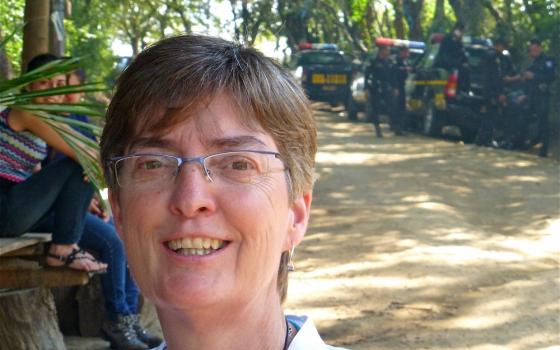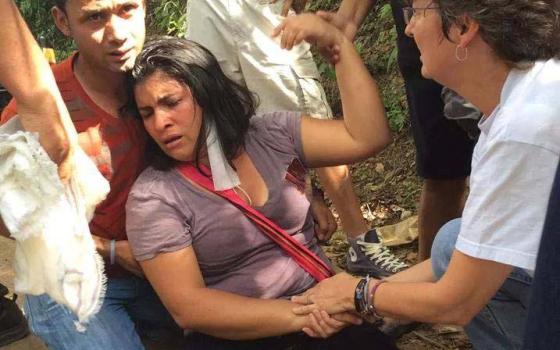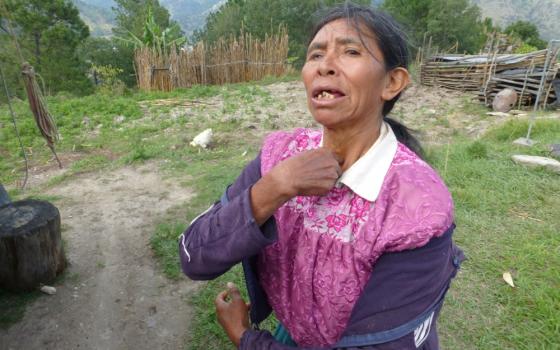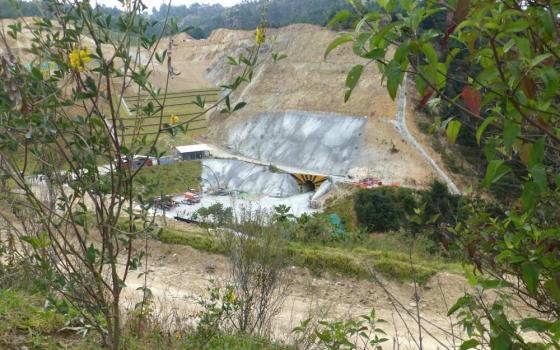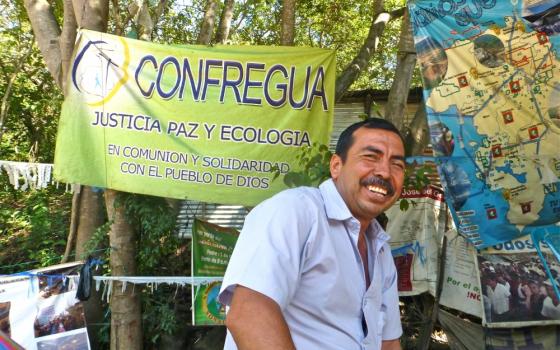In rural Guatemala, a red double-cabin pickup rumbles past a sign painted on a crumbling adobe wall, Community in Resistance. The lonely road is so rough that passengers leave seat belts unbuckled to avoid bruises from the shoulder straps. When the truck emerges from a forest, a clutch of shelters appears as if imagined into being by a writer of magic realism. In the middle of nowhere, it seems, shacks cobbled from reclaimed wood and tents made of scraps of discarded billboard canvas line the road for a quarter of a mile, festooned with maps and posters including an image of Pope John Paul II and the Maya calendar round. The red pickup stops in sight of hand-painted signs tacked to walls: No to Mining. Transnational Companies, Get Off Our Land. Sr. Dani Brought, 57, jumps out dressed in blue jeans and a crisp white shirt, her quick, light figure blending easily with those of the young people who gather around.
“I’ve known her for 15 years,” says Celestino Morales, a farmer who is sitting nearby on a three-legged stool in the shade as Brought, known as Sr. Dani, greets young and old, handing out bottles of drinking water. “She has accompanied us. When we least expect it, there she is.”
La Puya, as the makeshift settlement is called, has stood for three years outside a gold mine owned by the Reno, Nevada-based Kappes, Cassiday & Associates. The resisters are “a thorn in the side of the company and the government,” as one resident said, a protest against toxic contamination and a living demand that voices of those most affected be heard. La Puya is not unique but represents a global phenomenon in which local residents, often indigenous, almost invariably economically poor, are taking the lead in a struggle to protect the earth from harmful exploitation.
In the last decade, a worldwide boom in mining has ravaged delicate regions of developing countries like Guatemala. Governments give concessions for the extraction of raw materials to foreign companies, especially from Canada, the United States and China, without consulting local residents, ignoring the threat to wildlife and even to water. Good market prices and new technologies are encouraging extraction in areas once considered marginal, often home to indigenous people who have lived on the land for centuries or to peasant farmers. Governments may grant mines virtually unlimited use of resources in places where farmers lack sufficient water to grow their crops.
“Humans have almost cleared the surface of the earth. Now all efforts are geared towards going beneath the surface,” Gathuru Mburu, coordinator of the African Biodiversity Network, an advocacy group, told the British newspaper, The Guardian. In 2011, seven out of 10 of the world’s biggest new mining deals were made in Africa. “The continent has a history of acting as a feedstock for the world’s mineral hunger,” according to reports by KPMG, the global auditing company.
Sometimes distraught communities at the receiving end of the wreckage caused by the mining boom are fortunate to count on allies like Brought, a nurse, a professional health facility administrator, a Sister of the Adorers of the Blood of Christ and founder of the Sangre de Cristo Health Care Project headquartered in Lagunitas, about 45 minutes away by road. Since 1990, the proyecto has become a network of fixed and mobile clinics, pharmacies, dental clinics and laboratories that serve the long-neglected rural area just north of the capital, Guatemala City. Antonio “Tono” Reyes, director of the proyecto’s environmental health and sanitation program, first brought news of the coming mine to some local towns.
Customarily, Reyes’s program organized the building of latrines and wood-saving enclosed ovens and presented environmental awareness talks in schools. But when Reyes discovered government plans to give a concession for the gold extraction, without consultation with local communities, he facilitated meetings at night in far-flung hamlets where residents studied the mine’s possible consequences and considered their response.
“The war of the company and the government against the resistance is motivating us even more,” said Reyes. “We see how this is our Christian call, to defend life, defend water.” Shared leadership, he said, marks the resistance as “a movement of all, collective, with no owner.” This becomes important because “you lose everything with one leader if he’s bought off or murdered.”
On the recent visit to La Puya, Brought accepted a plate of chicken and beans cooked over a fire in a communal kitchen. In other open-walled shacks about 40 people, the day’s turno, or shift, rested in the shade, read or huddled in conversation. A hand-drawn sign on a wall demanded Dignity! Brought said she is most impressed with the non-violence that informs the resistance. “In my being I’ve learned from them about living your commitment no matter what the cost,” she said.
In Guatemala, the cost is high. In 2012 La Puya resister Yolanda Oqueli, 43, was shot by masked assailants on motorcycles after a demonstration. As she was being placed in the ambulance to a hospital, where she was treated and survived, the wounded activist was heard to say, “Keep praying. Remember this is non-violent.” (Soon after, the mine’s original owner, the Canadian company Radius Gold, sold its interest to junior partner Kappes Cassiday but retains an interest in the mine’s potential earnings.)
In May 2014, riot police attacked the peaceful, round-the-clock La Puya blockade of the mine entrance, injuring 20 people, seven of whom were hospitalized. Brought, caught with the news while at a meeting, rushed to the scene to help while health team members unable to travel prayed for hours around a burning candle set on the floor.
At La Puya, Morales, the farmer, pointed to a scar where a tear gas canister burst above his left eye on that day last year. “This pains me still, especially when the moon is full,” he said. As he spoke, police pickups were visible parked beyond the shacks, and armed police patrolled among nearby trees, a guardian force provided by the government for company vehicles and mine deliveries.
Four hours away from La Puya by road, residents fighting another mine in the western department of San Marcos speak of families broken up and of long-standing communities split in dissention over whether to resist or to sell land to the Marlin gold mine, owned by a subsidiary of the Canadian company, Goldcorp. On a green hillside, surrounded by her cows, sheep and turkeys, Diodora Hernandez, 67, popped out a false eye to show a visitor where an assailant’s bullet cost her half her sight and pointed to a scar on her neck where a second bullet entered. “They can shoot me again, but I won’t sell this land to the company,” she said.
Aniceto Lopez, 37, an agricultural and forest technician who became involved in resistance to the Marlin Mine seven years ago when he saw the company cutting local woods, shows a visitor an opaque, metallic-blue lake not far from where Hernandez grazes her animals. The lake receives tailings from the mining operations visible on a hill above the water, its eerie color created by the toxic waste, Lopez says. Rolling pale and straight nearby is an airstrip for planes that take the precious metal out of the country. Lopez is nervous.
The night before, after giving an informational talk to a local audience about the mine, and suggesting resistance, he stepped out from the meeting into the dark to find his motorbike’s back tire slashed. His activist work is “risky,” he said. “We just have to take care of ourselves.”
However, sometimes the activists cannot protect themselves. In an eastern Guatemala town called El Estor, on the wide Lake Izabal, a mother of six named Angelica Choc, 47, is suing the Canadian company Hudbay Minerals in Canadian courts for the 2009 machete murder of her husband, teacher and community activist Adolfo Ich Chaman, by security guards at the company’s Fenix nickel mine. (The mine’s operating company is now owned by the Cyprus-based Solway Group.)
“In the morning we had breakfast together, the family. In the afternoon my son, Juan Manuel, came to me. ‘They killed Daddy,’ he said.” The same day, a bystander, German Chub Choc, was shot by guards and left paralyzed; he now negotiates the rocky mountain paths of his village in a wheelchair. Ich, the teacher, and others had been outspoken about harms they said the mine caused their ancestral Q’eqchi’ Maya lands.
At the palm-filled lakeside town of El Estor, double rows of barbed wire surround housing facilities for mine employees. At the operations site where ore arrives, a smokestack rises painted with red stripes and the company letters, CGN, for Compañía Guatemalteca de Niquel. In the garden of a community law office in town, two of 11 women who joined Choc’s lawsuit recount their experiences under a spreading mango tree. The women charge that they were gang-raped by guards during a company-ordered eviction from disputed property, one morning in 2007 after husbands and sons had left for their fields. Rosa Elbira Choc Ich said as many as nine armed men entered her house and threw her on the floor, sexually abusing her without mercy.
“Thank God I can recognize some letters,” she said. “I saw the letters they had on their shirts: CGN.”
Margarita Caal Caal, a mother of four who also said she was raped, said, “What the company wants most is the land, but we don’t want to leave so they decided to abuse the women. It was a punishment. We women paid the consequences.”
In public declarations, and by way of booster-like campaigns, the companies deny wrongdoing and present themselves as reputable corporate citizens. On its website page devoted to Corporate Social Responsibility, Hudbay Minerals says of Adolfo Ich Chaman that the company believes mine personnel “were not involved with his death.”
During the week Aniceto Lopez found his tires slashed in San Marcos province, Goldcorp Incorporated’s Marlin Mine published a full-color, 12-page insert in a national newspaper highlighting what it described as the company’s responsible use of water, environmental monitoring and investment, and the creation of “sustainable value.” In a response to the Business and Human Rights Resource Centre, a British non-profit database, the owners of the La Puya mine said their operation was “fully permitted” and that part of the permitting process was “community involvement.” The firm said it was “doing everything we think is possible to reach out to, educate, and dialog with, the local communities.”
Huehuetenango Bishop Alvaro Ramazzini participated in demonstrations of protest against the Marlin Mine and presided at religious events calling attention to the resistance by residents in San Marcos, where he served as bishop for 24 years until 2012. He inaugurated a diocesan Pastoral Commission for Peace and Ecology, charged with offering “accompaniment” to communities threatened or in resistance to megaprojects. One report sponsored by the commission monitored three downwater points from the mining operations and found levels of aluminum, copper, arsenic and other elements surpassing world standards for open pit mining.
“Both mining and hydroelectric development appear in places that have not been taken into account for development,” said Ramazzini in an interview at the seat of the Episcopal Conference in Guatemala City. “People ask, ‘Why now, since we’re always forgotten? What benefits might come to us?’ And also, they say, ‘We have always been here – what danger is here for our own way of living?’”
The companies, he said, operate out of “a lack of understanding of the culture in the fullest sense of the term.”
Rights of affected communities are included in international treaties, said Julio Gonzalez of Madre Tierra, a non-profit environmental watchdog group. Guatemala, for instance, is a signatory to the International Labour Organization’s Convention No. 169, which mandates consultations with indigenous communities that will be affected by mining, logging and so-called development projects. Dozens of consultations among Maya communities in San Marcos, whose results ran against the Marlin Mine, appear to have been ignored. The companies, said Gonzalez, “do another kind of survey, asking whether [local residents] want to work equipment or would like a company house. That’s not the kind of consultation required by the spirit of 169.”
Ramazzini said he does not believe it is the intention of companies to divide communities. “But when they get licenses they feel they have permission from the government and that’s all that’s needed. They do not work with dialogue first.” Compliance with the ILO Convention’s No. 169, he said, offers a solution. “Consultation provides a guarantee. Consensus before a project is key.”
When residents of San Pedro Ayampuc, where Sr. Dani Brought’s health proyecto is, and San Jose Del Golfo, on the other side of the local mine, first met to exchange information and begin the resistance, Ramazzini came and spoke to them of the San Marcos experience, locals said, encouraging them in the justice of their quest. Some said that to understand that their effort had the respect of the bishop, who is known as a voice for the country’s poor, gave them courage.
“We believe God will guide us,” said carpenter Carlos Oliva. When he can, Oliva said, he goes on the Internet with his nephew, Elija, to investigate the effects of gold mining and to read what others have done in the face of unwanted mines. He said local media give an inaccurate view of the mine and its resisters.
“They buy the press here and say this is progress, but we know it’s not true. The Internet helps – they can’t fool us now.”
Some 200,000 persons died or disappeared at government hands during the 36-year civil war in this country that ended in 1996. Almost all who were lost were unarmed civilians, like those who continue the vigil at La Puya. Men and women of all ages who take their turnos here, in heat and cold, and see themselves as bearing witness to resistance as they pray together, try to meet with officials and entertain delegations from other places in the country of people like themselves, up against mines and other projects unfolding against their will.
“We’re worried about contamination, about the chemicals and arsenic they will use,” said former policeman Alvaro Oliva, an early occupier at La Puya. Micaela Castellano, 45, cooking for the others over an open fire, doesn’t see herself as brave, but said she is afraid, “all the time.” Her seven children worry, she said, that one day she and her husband won’t come home from their shift days at La Puya, but they regularly appear for their turnos.
The terrible toll in lives of the recent civil war might be thought to discourage resistance to authority in this country, even elected authority. Nevertheless, those who resist the mines and massive “development” projects are “convinced, strong, decisive,” said Ramazzini.
[Mary Jo McConahay is a prize-winning author, documentary filmmaker and freelance journalist who has reported widely on social justice issues.]
